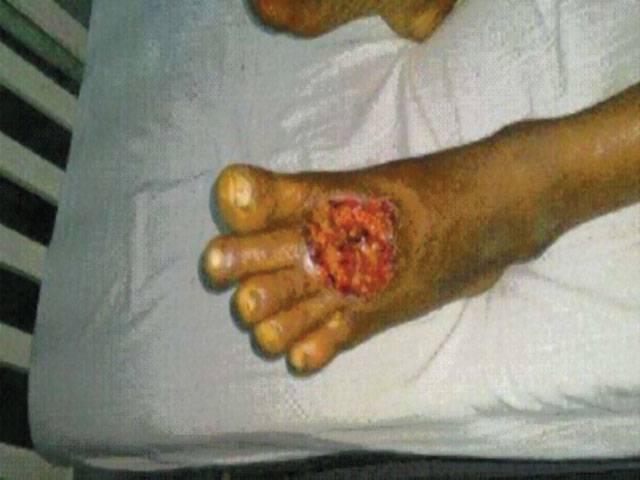MULTAN-Cutaneous Leishmania, an epidemic skin disease, has found its way to Multan after considerable damage in Karak and Kohat areas of KPK where 300 persons were reported to have been affected by the disease in January and February this year.
Caused by a sand fly, it has been listed among 17 neglected diseases in the world by World Health Organisation (WHO). More than 14 patients have contracted this vector born disease in just 30 days starting from 13 February, 2014, according to a survey conducted by university students.
The fly likes to hibernate at hot days and is active during dusk and dawn and hides under filth. By the simple pinch of fly bite, causing a horrible soar that is difficult to heal and terrible to treat. If untreated it could melt the soft tissues of arm, nose, cheeks, legs and feet.
Medics have warned that it could lead to epidemic if unleashed and an alarming situation could cause insomnia to residents of Multan. The adjoining area and new town could be attacked by the pest.
The disease is also prevalent in other parts of Pakistan and has been reported from almost all major cities. It is endemic in Sindh, Baluchistan, KPK and Multan.
The WHO has also been working with local health authorities in the KPK province of Pakistan to control the outbreak and has listed it in17 neglected diseases in the world.
Leishmaniasis is a vector borne disease caused by a protozoan. The sand fly (phlebotomies or midges) plays a major role in dissemination of the disease in 88 countries of the world. The Leishmaniasis can be grouped in two forms one is visceral Leishmaniasis that is rarer in Pakistan and affects the internal body parts particularly the spleen and liver. The second is cutaneous type that is commonly known as ‘Kala Dana’ in Pakistan.
In Cutaneous form, the lesions are usually single but a presentation with multiple ulcers resulting from multiple bites by the female sand fly and it is very common here in this part of the globe.
The organism responsible for Leishmaniasis was discovered more than 100 years ago but the disease has not been eradicated in many parts of the world including Pakistan.
Most infections are initiated with a minor bite from an infected sand fly after an incubation period of 1-12 weeks, a papule develops that enlarges and ulcerates. A typically lesion is a painless ulcer with necrotic base. Most patients have one or two lesions but lesions are multiple and occur in crops.
Some lesions do not ulcerate and remain bluish papules. Most lesions heal over months or years leaving an atrophic scar sign. In general lesions associated with Leishmania major, it may heal in 3 months, Leishmania tropica may take about a year while Lbrazilienesis may persist much longer.
Following methods can be adopted for it diagnosis like smear stained with giemsa, methods like PCR or rare time RT-PCR are more sensitive than the conventional methods like microscopy or serology (Elisa).
For the cure of Cutaneous Leishmaniasis, a couple of medicines are available but less marketed in Pakistan. Among them, glucantime, which was developed in early 1940’s remaining the mainstay of systematic treatment. Sodium stib gluconate is best given once daily by sloe IV or IM injections for up to 2 weeks. Toxicity in most patients develops like Malaise, Anorexia, Myalgia and Arthralgia after 14 days of treatment.
Patients should be monitored regularly for complications. The good signs like less indurate, flattened and less scarred area of skin will be visualized with adequate treatment. Alternative systemic agents include Aminocidine, Pentamidine and Ketoconazole are used. Certain creams from marine origin have been claimed from Karachi University to be of some curative potential.
Other methods like Cryotherapy are also useful for small lesions less than 1 cm in diameter. No vaccine is available but sub-unit vaccine like K-39, A-2 are tried with little success rate.
Dr. Muhammad Mahar Ayaz, Muhammad Shahid and Mukaram Sultan Sahu. Department of Patho Biology, Faculty of Veterinary Sciences BZU, Multan
Email: mazharayaz@bzu.edu.pk
Monday, May 13, 2024
EPIDEMIC SKIN DISEASE DETECTED IN MULTAN

Caption: EPIDEMIC SKIN DISEASE DETECTED IN MULTAN
More witnesses to testify in £190m corruption case today
11:38 AM | May 13, 2024
Autopsy fails to determine cause of housemaid’s death in Karachi
10:08 AM | May 13, 2024
Chinese engineer rescued from River Jhelum peril
May 13, 2024
Teachers Panel sweeps ASA election at IIUI
May 13, 2024
Indigenous Armaments
May 13, 2024
The Path Ahead
May 13, 2024
Bridging Divides
May 13, 2024
A Global Problem
May 12, 2024
Symbolic Victories
May 12, 2024
Climate awakening
May 13, 2024
Tourism conundrum
May 13, 2024
Hockey despair
May 13, 2024
Public policy issues
May 13, 2024
Data nexus
May 12, 2024
ePaper - Nawaiwaqt
Advertisement
Nawaiwaqt Group | Copyright © 2024





